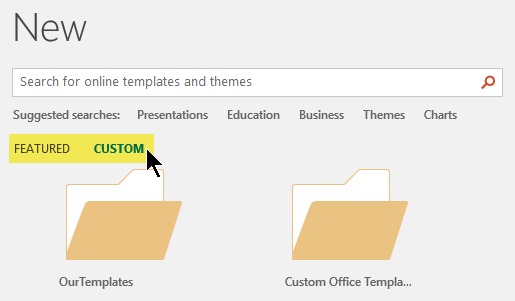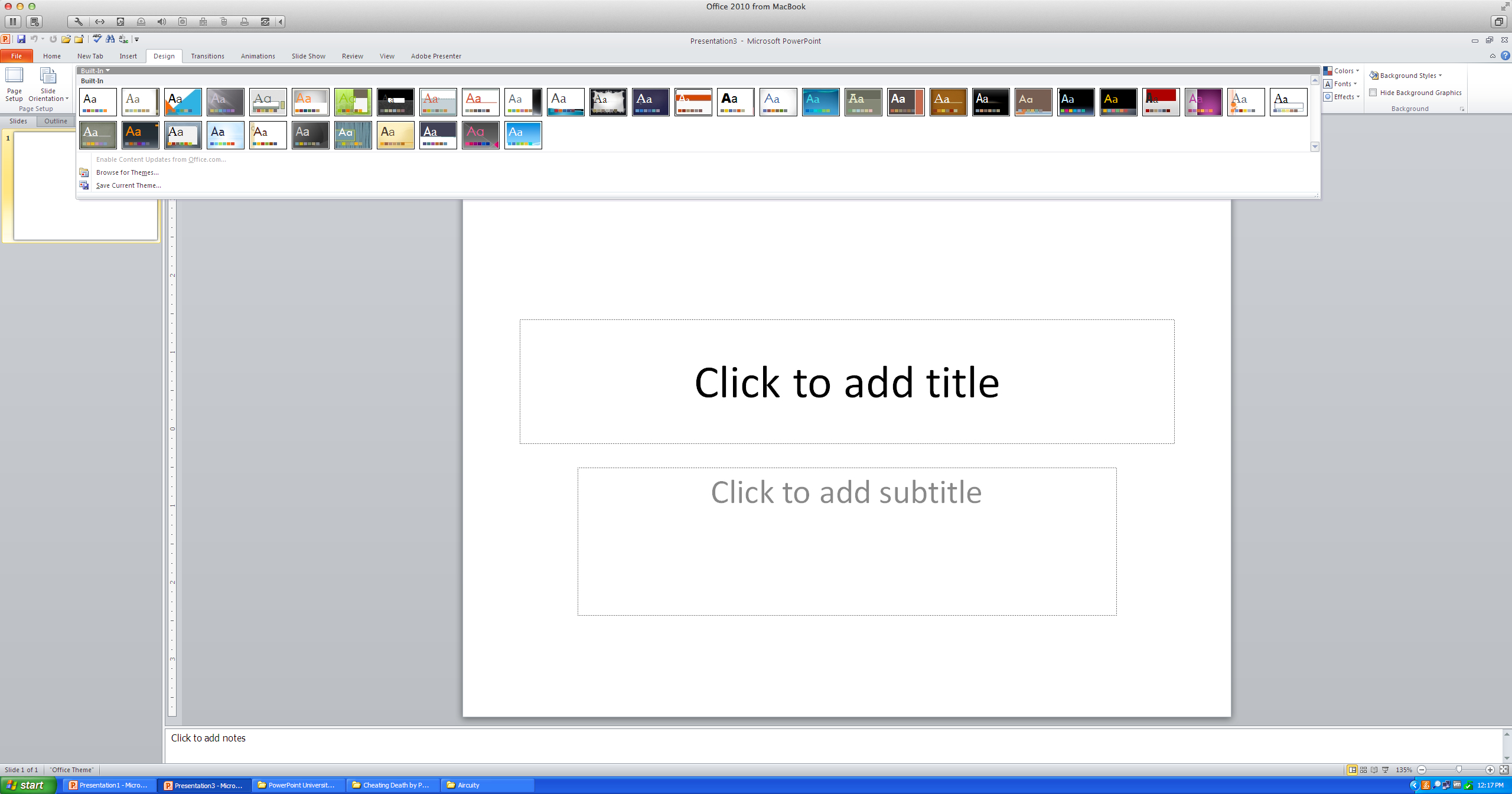-->
You can use PowerPoint add-ins to build engaging solutions for your users' presentations across platforms including Windows, iPad, Mac, and in a browser. You can create two types of PowerPoint add-ins:
- Oct 06, 2017 How to Download and Install a PowerPoint Template. The good news is that it's quick and easy to add custom themes to PowerPoint for a unique look. The Beginner's Guide to Microsoft.
- Dec 05, 2016 Install Your Premium PowerPoint Template. Let's jump back over to PowerPoint. Go to the File Options menu and in the Save panel, find the box that says Default Personal Templates Location. This is the folder where PowerPoint will look for your templates. Paste in the path to where your custom templates are stored and then press OK.
Step 1 in creating a custom template: Create a custom color scheme. A color scheme is a collection of color settings that, together, define the colors used in a PowerPoint presentation. To create a custom color scheme: 1. Choose FormatSlide Color Scheme to display the Color Scheme window.
Use content add-ins to add dynamic HTML5 content to your presentations. For example, see the LucidChart Diagrams for PowerPoint add-in, which you can use to inject an interactive diagram from LucidChart into your deck.
Use task pane add-ins to bring in reference information or insert data into the presentation via a service. For example, see the Pixton Comic Characters add-in, which you can use to add professional photos to your presentation.
PowerPoint add-in scenarios
The code examples in this article demonstrate some basic tasks for developing add-ins for PowerPoint. Please note the following:
To display information, these examples use the
app.showNotificationfunction, which is included in the Visual Studio Office Add-ins project templates. If you aren't using Visual Studio to develop your add-in, you'll need replace theshowNotificationfunction with your own code.Several of these examples also use a
Globalsobject that is declared beyond the scope of these functions as:var Globals = {activeViewHandler:0, firstSlideId:0};To use these examples, your add-in project must reference Office.js v1.1 library or later.
Detect the presentation's active view and handle the ActiveViewChanged event
If you are building a content add-in, you will need to get the presentation's active view and handle the ActiveViewChanged event, as part of your Office.Initialize handler.
Note
In PowerPoint on the web, the Document.ActiveViewChanged event will never fire as Slide Show mode is treated as a new session. In this case, the add-in must fetch the active view on load, as shown in the following code sample.
In the following code sample:
The
getActiveFileViewfunction calls the Document.getActiveViewAsync method to return whether the presentation's current view is 'edit' (any of the views in which you can edit slides, such as Normal or Outline View) or 'read' (Slide Show or Reading View).The
registerActiveViewChangedfunction calls the addHandlerAsync method to register a handler for the Document.ActiveViewChanged event.
Navigate to a particular slide in the presentation

In the following code sample, the getSelectedRange function calls the Document.getSelectedDataAsync method to get the JSON object returned by asyncResult.value, which contains an array named slides. The slides array contains the ids, titles, and indexes of selected range of slides (or of the current slide, if multiple slides are not selected). It also saves the id of the first slide in the selected range to a global variable.
In the following code sample, the goToFirstSlide function calls the Document.goToByIdAsync method to navigate to the first slide that was identified by the getSelectedRange function shown previously.
Navigate between slides in the presentation
In the following code sample, the goToSlideByIndex function calls the Document.goToByIdAsync method to navigate to the next slide in the presentation.
Get the URL of the presentation
In the following code sample, the getFileUrl function calls the Document.getFileProperties method to get the URL of the presentation file.
Create a presentation
Your add-in can create a new presentation, separate from the PowerPoint instance in which the add-in is currently running. The PowerPoint namespace has the createPresentation method for this purpose. When this method is called, the new presentation is immediately opened and displayed in a new instance of PowerPoint. Your add-in remains open and running with the previous presentation.

The createPresentation method can also create a copy of an existing presentation. The method accepts a base64-encoded string representation of an .pptx file as an optional parameter. The resulting presentation will be a copy of that file, assuming the string argument is a valid .pptx file. The FileReader class can be used to convert a file into the required base64-encoded string, as demonstrated in the following example.
See also
Have you wondered where the Themes and templates you save from within PowerPoint or other Office applications are located? Rememberthat your custom Themes and templates location is different than the location wherePowerPoint’s built-in Office Themes are saved.
The location for these Themes and templates is important because you may want to share these with colleagues, clients, friends, orfamily. If you know where you can find these Themes and templates, you can make sure that they are copied to corresponding folders onother computers. And if you are a template designer or even a sysadmin at a large company, this information can be invaluable.
Microsoft Powerpoint Mac Add Custom Templates Free
When you save a Theme or template within PowerPoint, you will automatically be prompted to save in the designated folder. These samedesigned locations are only provided here.
Office 2016, 2013, 2010, and 2007 on Windows 10, 8, 7, and Vista
The location is C:Users< Username >AppDataRoamingMicrosoftTemplatesDocument Themes, as shown in Figure 1, below.
Figure 1: Location of Themes in recent versions of PowerPoint on Windows
Microsoft Powerpoint Mac Add Custom Templates Free

Office 2010 or 2007 on Windows XP
The location is C:Documents and Settings< Username >Application DataMicrosoftTemplatesDocument Themes, as shown inFigure 2, below.
Figure 2: Location of Themes in versions of PowerPoint on Windows XP
Office 2016, 2011 or 2008 on Mac OS X
Although you can designate a My Themes folder in Office versions of the Mac, there is a default location that’sused if no designated location is created. This location is Macintosh HD:Users< Username >:Library:GroupContainers:UBF8T346G9.Office:User Content:Themes, and it is very difficult to manually go to this location using the Finder.To access this location, follow these steps:
- Press the Opt/Alt key on your keyboard as you access OS X’s Go menu,and you will magically see an extra option in the menu called Library, as shown in Figure 3,below. Choose this option.
Figure 3: Press the Opt/Alt key when you access the Go menu- Now navigate to the Macintosh HD:Users< Username >:Library:Group Containers:UBF8T346G9.Office:User Content:Themesfolder, as shown in Figure 4, below.
Figure 4: Location of Themes in versions of PowerPoint on Mac OS X
Note: Substitute < Username > with a folder typically named after the user. Most of the time, this could be your name.The paths mentioned assume that you installed to your C drive (on Windows) or the Macintosh HD drive (on Mac OS X). If you installed toanother drive, you will substitute the drive in your path. Also, you may have changed the name of your Microsoft Office folder toMicrosoft Office 2016 or a similar name for other versions of Microsoft Office. In that case, your paths may differ on account ofdifferent folder names.
In addition to Themes (THMX files), you can also save POTX (PowerPoint templates) in some locations so that they show up as options,based on which you can create new presentations in PowerPoint.
Office 2010 or 2007 on Windows 10, 8, 7, and Vista
Microsoft Powerpoint Mac Add Custom Templates Download
C:Users<Username>AppDataRoamingMicrosoftTemplates